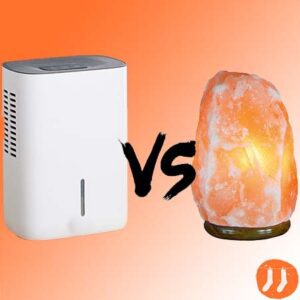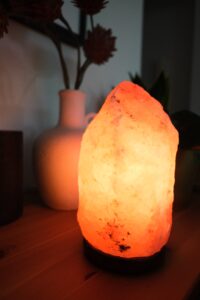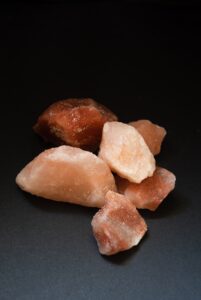
Will a Salt Lamp Dehumidify?
To be healthy, as well as to improve the condition of the lungs, and bronchi, a salt lamp is very often used. What are the advantages of this device? Does the salt lamp dehumidify the air in the room? About this and much more will be discussed in this article.
Have you ever heard that Himalayan salt lamps have been on sale? At first glance, they are just regular big pieces of pink stone mined and carved in the mountains of the Himalayas. As a product, a salt lamp is a large and decorative object; something like a salmon-colored crystal.
But when you turn it on, you see a soft, soothing pinkish glow. Salt lamps are often considered home and wellness products that help people relax and get rid of stress. Added to this is some speculation that salt lamps can act as natural dehumidifiers.
When we talk about dehumidifiers, we are referring to appliances specifically designed to reduce the moisture content of indoor air and keep the humidity at a given level.

Salt Lamps As Natural Dehumidifiers
Many people think of salt lamps as a natural dehumidifier that can also reduce indoor humidity. But is this true?
hat’s the million-dollar question, and the simple answer is yes. Salt is known as a natural moisture absorber. Have you ever wondered why salt can stick together if left in a salt shaker in humid weather?
This falls under the “doctrine” of physics. Salt absorbs moisture, causing the grains to stick together. A more effective natural dehumidifier would be rock salt, of which a salt lamp is made. Sodium chloride is inherently hygroscopic and can absorb moisture from the air quite well.
This is why calcium silicate is often added to table salt to prevent caking. As a naturally occurring salt, Himalayan salt bulb consists mostly of sodium chloride, although it may contain some traces of iron, zinc, and potassium.
Therefore, it’s safe to say that salt lamps are dehumidifying and can help reduce the moisture content of the air.
Thus, you can leave them off in dry weather. However, if they start “crying” when the humidity increases, it’s time to turn them on to reduce the humidity in your home.
It is common to use such devices in regions with high humidity, for example, if you live by the sea or by a river. In addition to dehumidification, salt lamps can also help neutralize some of the odors in your room, especially those caused by excessive humidity.
You should also be careful because salt lamps can “drip” or sweat if your room is very humid and your lamp is off. It is important to leave it on as long as there is moisture in the air that needs to be removed.
This ensures that the heat dissipates the moisture that the lamp absorbs. Some experts say that the lamp releases negative ions into the air, which can affect air quality.

So, is it basically possible to use a salt lamp as a dehumidifier instead of a dehumidifier? Can dehumidifiers even be compared to salt lamps? What are the advantages of one over the other?
Similarities
- Both a dehumidifier and a salt lamp are powered by electricity.
- A salt lamp and a dehumidifier collect moisture from the air.
- They are both household appliances for home use.
Differences
- By design, a Himalayan salt lamp and a dehumidifier are two different devices designed for different purposes. While a salt lamp is primarily designed to uplift your mood and relieve stress through its pink glow, a dehumidifier is primarily designed to dehumidify your home. Salt lamps can only dehumidify secondarily. Also, a salt lamp is more or less a set of small pinkish stones with light bulbs inside that illuminate the salt stones.
- The dehumidifier is a boxed device with vents, filters, tanks, etc. A salt lamp, on the other hand, is simply naturally assembled salt stones in a bowl-shaped object and a light bulb plugged in for illumination.
- The dehumidifier can cover more space because of its mode of operation. It has a fan that blows cooler, drier air into the room. Meanwhile, a salt lamp can only remove the moisture inside its space.
- A dehumidifier’s dehumidifying capacity is much greater than that of a salt lamp. While a standard dehumidifier can remove 15% to 25% of the moisture in a room in a matter of hours, a Himalayan salt lamp may not exceed 10% of the removal ability.
Where is the best place to put a salt lamp?
The best place to put a salt lamp is on a coffee table or coffee table. It can be placed next to a chair while you sit and watch the evening news. Another good place to store the salt lamp is a home shelf.
Make sure it is placed high up, away from the access of children and pets.
This ensures that the lamp will work without any problems. It can also be placed on a desk, in a massage room, or anywhere else in the home or office.

Where can’t I put a salt lamp?
If you live in a very dry area with little or no humidity, you may not need to have a salt lamp on except for other purposes.
As far as locations for the lamp, avoid damp places that can cause the salt to dissolve. Also, do not store it where children can knock it over and cause injury.
Also, make sure it is out of reach of pets because dogs or cats can ingest too much salt, which can cause salt poisoning with symptoms such as seizures, diarrhea, vomiting, drowsiness, or even death.
Salt lamps should be considered one of nature’s wonders. These crystals and stones, hand-mined in the rich Himalayan mountains, are designed to provide the right ionic balance in the air for cleansing and freshness.
They are also pleasant to look at, they help you fall asleep or meditate, and at night they can simply be used as an aesthetic lamp. But that’s not all; like natural salt, these lamps are rich in sodium chloride, which acts as a natural dehumidifier.
When used properly, salt lamps can significantly reduce humidity. However, a salt lamp may not be able to handle excess moisture in high-humidity conditions.
——
